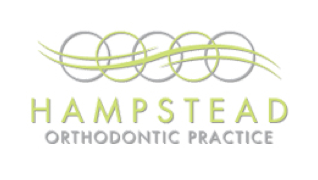6 Different Types Of Braces: Which Is Best For You?

At Hampstead Orthodontic Practice, we provide a wide range of braces and orthodontic treatments that cater to everyone. Our team will work with you to find the perfect solution by making a treatment plan that accommodates your every need.
1. Damon® Brackets
Damon® braces were invented by Dr. Dwight Damon. The Damon® bracket utilises (sliding-door) technology known as “self-ligation” that allows the wire to slide back and forth within the bracket.
No elastic or steel ties are used with Damon® brackets. Similar to other self-ligating braces, Damon braces use a slide mechanism to hold the wire in place, allowing the teeth to move more freely, quickly, and comfortably. This technology creates less friction and results in greater comfort for the patient. In addition, Damon® braces often reduce both treatment time and the number of adjustments that are usually performed.
Pros:
- Comfort: Less pressure on the teeth, leading to more comfort.
- Fewer adjustments: Requires fewer orthodontic visits.
- Potential for faster treatment: May shorten treatment time.
Cons:
- Appearance: Still noticeable, although less so than traditional metal braces.
- Cost: Generally more expensive than traditional braces.
2. Symentri Clear Braces
If you’re looking for a more aesthetically pleasing alternative to metal braces, Symentri Clear Braces may be for you. Crafted from clear sapphire, these braces are also very strong and dependable.
They function similarly to traditional metal braces but with a more aesthetic approach. The brackets and wires apply pressure on the teeth to move them into alignment. Check with your orthodontist to see if Symentri clear braces are right for you.
Pros:
- Aesthetic appeal: Less noticeable than traditional braces.
- Effective: Can treat a wide range of orthodontic issues.
Cons:
- Cost: More expensive than traditional braces.
- Fragility: Brackets can be more prone to breaking.
- Discomfort: Similar to traditional braces in terms of discomfort.
3. Incognito™
Incognito are a new generation of orthodontic braces for teens and adults. They are the only 100% customised orthodontic braces available on the market today. Incognito are placed behind your teeth so no one will know that you are wearing braces unless you tell them.
These unique braces are created using state-of-the-art technology and are 100% customised to the shape of your teeth and your dental situation. They apply pressure on the teeth through the wire, moving them into the desired position. With Incognito, you get efficient, effective tooth movement and great aesthetics.
Pros:
- Invisibility: Completely hidden from view.
- Effectiveness: Can handle complex cases that aligners may not be able to.
Cons:
- Discomfort: Can cause tongue irritation and may affect speech.
- Difficulty in cleaning: More challenging to maintain oral hygiene.
- Cost: More expensive than traditional and ceramic braces.
- Complexity: Longer adjustment period, both for fitting and getting used to them.
4. Invisalign®
The Invisalign System is a series of clear overlay templates—called aligners—that have been generated by computer simulation to gradually move the teeth. This system is available to adult patients with certain orthodontic bite problems. Ask us if you are a candidate for the Invisalign system.
Invisalign works by wearing a series of clear aligners that gradually shift the teeth into the correct position. Each set of aligners is worn for about two weeks before switching to the next set in the series.
Pros:
- Aesthetics: Virtually invisible, making them a popular choice for adults and teens.
- Removable: Can be taken out for eating, brushing, and flossing.
- Comfort: No metal parts to cause irritation.
Cons:
- Compliance: Requires discipline to wear aligners for 20-22 hours per day.
- Effectiveness: May not be suitable for very complex cases.
- Cost: Generally more expensive than traditional braces.
- Maintenance: Aligners need to be cleaned regularly, and teeth must be brushed after every meal before putting them back in
5. Metal Braces (Traditional Braces)
Metal braces are the most common and well-known type. They consist of metal brackets attached to the teeth and connected by a wire, which is adjusted periodically to gradually move the teeth into the correct position.
The metal brackets apply pressure on the teeth through the wire, which is periodically tightened by the orthodontist. Over time, this pressure moves the teeth into the desired alignment.
Pros:
- Effective: Highly effective for most orthodontic cases.
- Durable: Made of strong materials that resist breakage.
- Cost-effective: Generally the most affordable option.
- Faster: Tends to achieve results quicker than other types of braces.
Cons:
- Appearance: Visible and can be aesthetically displeasing.
- Discomfort: Can cause irritation inside the mouth, especially in the beginning.
- Dietary restrictions: Certain foods need to be avoided (e.g., hard or sticky foods).
6. Ceramic Braces
Ceramic braces function similarly to metal braces but use clear or tooth-coloured ceramic brackets, making them less noticeable.
They work the same way as metal braces by applying pressure on the teeth with wires connected to ceramic brackets.
Pros:
- Aesthetic: Less noticeable than metal braces.
- Effective: Comparable effectiveness to metal braces.
Cons:
- Fragility: Ceramic brackets are more prone to breaking.
- Cost: More expensive than traditional metal braces.
- Staining: The ceramic brackets can stain if not properly cared for.
Who Can Get Braces?
Children’s Braces
Children’s Braces can help prevent further complications with your teeth in the future. Although it is possible to straighten your teeth at any time in your life, it’s best to get braces in your younger years. Starting the process earlier is the best way to minimise the length and severity of orthodontic treatment.
Adult Braces
Thanks to advancements in orthodontic treatments bringing us less intrusive ways to straighten our teeth, more and more adults are now opting for braces. The trend of adult braces won’t stop any time soon, with a lot of older patients reporting that their orthodontic treatment drastically improved their appearance and self-esteem.
If you’re considering receiving one of the above orthodontic treatments, why not get in touch with our team of orthodontic experts and book a free consultation with us today? Or alternatively, call us on 020 3733 4187.


